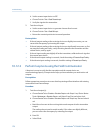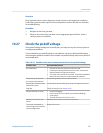
Tip
For typical applications, Micro Motion recommends setting Mass Flow Cutoff to the zero stability value
for your sensor, multiplied by 10. Zero stabiliy values can be found in the Product Data Sheet for your
sensor.
10.25 Check for slug flow (two-phase flow)
Slug flow (two-phase flow, entrained gas) can cause spikes in the drive gain. This may
cause the transmitter to report zero flow, or to post several different alarms.
1. Check for slug flow alarms.
If the transmitter is not generating slug flow alarms, slug flow is not the source of
your problem.
2. Check the process for cavitation, flashing, or leaks.
3. Monitor the density of your process fluid output under normal process conditions.
4. Check the settings of Slug Low Limit, Slug High Limit, and Slug Duration.
Tip
You can reduce the occurrence of slug flow alarms by setting Slug Low Limit to a lower value,
Slug High Limit to a higher value, or Slug Duration to a higher value.
10.26
Check the drive gain
Excessive or erratic drive gain may indicate any of a variety of process conditions, sensor
problems, or configuration problems.
To know whether your drive gain is excessive or erratic, you must collect drive gain data
during the problem condition and compare it to drive gain data from a period of normal
operation.
Excessive (saturated) drive gain
Possible causes and recommended actions for excessive (saturated)
drive gain
Table 10-8:
Possible cause Recommended actions
Slug flow Check for slug flow. See Section 10.25.
Partially filled flow tube Correct process conditions so that the flow tubes are full.
Plugged flow tube Check the pickoff voltages (see Section 10.27). If either of them are
close to zero (but neither is zero), plugged tubes may be the source
of your problem. Purge the tubes. In extreme cases, you may need
to replace the sensor.
Troubleshooting
Configuration and Use Manual 185


















